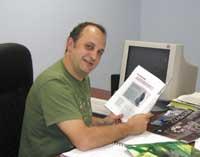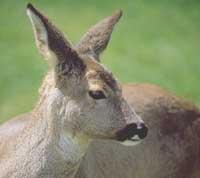Mario Sáenz de Buruaga: "Animals are wildlife before hunting"
We already have the time of very advanced hunting and in Euskal Herria, besides the contrary to hunting, there are many hunters. How many hunters or licenses are there?
It changes year after year, I don't know exactly how many they are, but I think they are about 40,000. The Basque Country has the second highest density of hunters in the world, placing it in Malta.
But is there hunting for everyone? What do they hunt?

In Euskal Herria, as in other places, you hunt what you can. But we must differentiate two zones: In Bizkaia, Gipuzkoa and Iparralde are hunted mostly migrants. In the south of Alava and Navarre, the hunting of migrants is carried out with less intensity and the hunting of sedentary species, mainly partridge, hare and rabbit. I always refer to the smaller hunt. As for the main hunt, it is hunted throughout Euskal Herria, as the wild boar, the deer and the deer. It can be said that they are good times for greater hunting and bad for smaller hunting.
There are several forms of hunting. What are the most common in our environment?
The most common among the minor and migratory hunting are, undoubtedly, the hunting of the dove from the dove stands and the hunting of the calf with hunting dog. Also in Alava, hunting partridge and quail with dog. And in greater hunting, beaten to the wild boar and, in recent years, hunting to the stalk of the roe deer. In Gorbeia (Araba and Bizkaia) deer shakes are also made.
When shelters are named or some species is forbidden, hunters complain, do not like, but taking this same measure in other territories is beneficial to local hunters.
What he has mentioned is very important, since at European level there are no platforms that elaborate international hunting plans. That would be really interesting: If from the Bizkaia Provincial Council they call the institutions of Denmark, Germany, Finland and Russia and, for example, from the censuses, they say that the scholarship has fallen very badly this year, not being able to hunt here. But we don't have that. This is one of our biggest problems.
On the other hand, there is a principle of solidarity in the hunt for migrants, but it is not taken into account. That's why I never liked the counterweight. Not for the amount of pigeons being hunted. It doesn't seem good to me to shoot on the long one-way trip, shoot during the winter and hunt again when they get back to breeding. And also, in time of breeding of other species.
We have mentioned the ways of hunting, each should be managed differently, should it not?
Yes, of course. In migration, for example, I claim to be careful with the quotas. With this, at least on occasions, it is avoided that in those dates of strong sedentarism suffered by the migratory hunt in the RD, such as colds, bad weather, etc., extraordinary catches occur. This is the case of the scholarships.
In the sedentaries it should be analyzed in each case. On the one hand, the study of the available population and, on the other, the basic study of the habitat. All this must be reflected in a quota and, finally, follow up.
Is a follow-up done?
It is worrying, but this part is practically abandoned. We could make a very good plan, five years fixing the demographic models, but if in the second year the cotton has been burned, we should review it; or if for two years we have suffered a strong drought, equal. I do not like how this follow-up phase was articulated in the regulations.
Be careful, however. Normally we remember a greater limitation of hunting with quotas and plans. But the opposite can also happen. In the last two years, the rabbit population in Navarre has grown considerably, which is spectacular from an ecological point of view. But if in the previous plan there could be 2 hunting rabbits per day, you can now climb the quota to 10. The plan must be a dynamic tool.
Yes, but perhaps with the number of rabbits and cupos, an eagle could hardly be fed. But, when you add the rabbit, does the cupo rise and the eagle follow in the past? Or is the possibility of improving your situation also analysed?

That would be the most appropriate. In theory, in a plan of ordination it would have to take into account the predators, the state of the fauna, the predators... but we cannot deceive anyone, usually the hunt is the core of the plan. A technician should use the principle that animals are wildlife before hunting and see the entire ecosystem. But in the censuses we do not work so much with the densities of predators. Why?
The hunter cannot pay for a doctoral thesis in each plan. In this question you claim the total ethics of the technicians and that worries me, because I know that there are technicians who have made plans without getting up from the table.
He has said that territories with minimal management have more fauna than free spaces. Does the possession and management of hunting species also benefit other species, as is the case with emblematic species?
The bear and the like are called umbrella species. When performing a good management of the bear it is believed that the management of the forest is good, which benefits many others. In the case of hunting, the pieces are usually prey species, located in the trophic pyramid below, and I do not see them acting like the previous ones. Of course, as a result of planning, quotas are respected and habitats are improved... and, in principle, these habitat improvements can be beneficial for the entire ecosystem, from that point of view yes.
Historically the ‘beasts’ have died in cars. Is it still done?
The predators die, which are, after all, the beasts, and cause problems in some places, especially the generalist predators. But its control is of very little tradition, of little interest, of great weariness and, moreover, of little gastronomic interest. At the end of the hunting season, hunters forget; it would be good to ask for permits to reduce corvids, for example. Formerly, a barbarity was made: using poison. Today, however, we must resort to other techniques such as the homologation of a system of traps, the transfer of animals collected alive or dead… That is not established in our regulations.
In addition to generalists, those who can actually kill hares, rabbits and partridges, royal eagle, royal eagle, solar eagle, royal owl, azor eagle, etc., are unfortunately very few. And on the other hand are the carnivores, I believe that in general they are no problems anywhere.
Yes, but who are we to decide on your control? If the foxes have proliferated by the neck of the prey, to what extent could we put the hand?
From the moment a commercial framework has been consolidated between owners, owners and administration there are rules of play. It is not to say that here we charge, we manage… but if there is a strong proliferation of foxes that will end with the term capital, you can not touch any steel. It would not seem good to me. In the end, we should say that hunting, as an activity, must disappear and that the ecosystem should continue on its own. But logically, on its own, it is not to continue in the eranatural.
On the other hand, I will not claim the mere economic profitability of hunting, but I will not put it aside. And it is that where the rural population is decreasing, hunting, at least, generates an important economic movement. It is estimated that in the Spanish state it moves 400,000 million pesetas.
Full interview: www.zientzia.net
Buletina
Bidali zure helbide elektronikoa eta jaso asteroko buletina zure sarrera-ontzian











